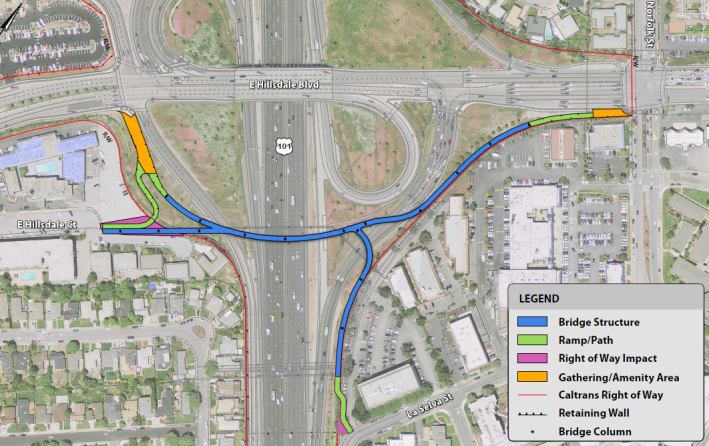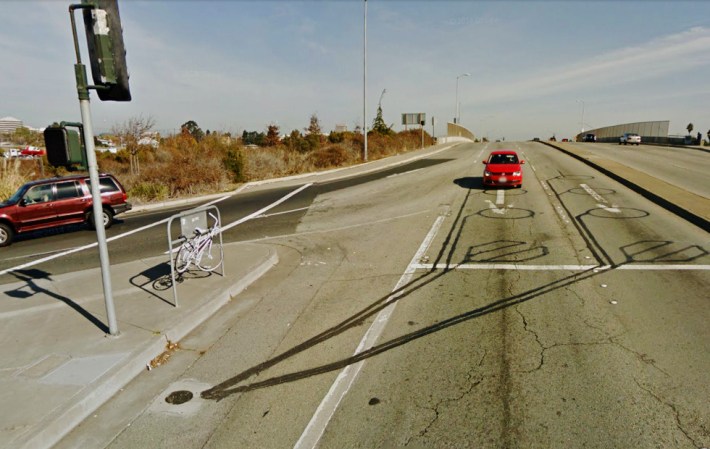San Mateo’s Hillsdale Ped/Bike Bridge Moves Onto Final Regulatory Hurdle
5:15 PM PDT on August 28, 2014

Last Monday, San Mateo's City Council reviewed a draft report ahead of the last step in the permitting process for the city's ambitious Hillsdale Pedestrian/Bicyclist Bridge over Highway 101. The bridge has been needed ever since the interchange was rebuilt and expanded in 2002, which made crossing the highway more hazardous for people walking and bicycling. The following evening, city staff hosted a community meeting to gather residents' preferred design alternatives for accessing the bridge from the surrounding neighborhoods.
The interchange's "full to partial cloverleaf conversion" in 2002 enabled more car traffic to cross and access the highway by removing the southwest and and northeast loops, but nothing mitigated the new safety hazards that result from higher traffic volumes, speeds, and poor sight lines.
68-year-old Palo Alto resident Theodore Hinzte was struck and killed by the driver of a California Department of Transportation (Caltrans) vehicle in December 2009, while Hinzte was bicycling on Hillsdale across the double-lane on-ramp to southbound Highway 101. Someone is hit by a car while walking or biking across the interchange at least once every four months, according to collision data summarized in the report:
"The existing five-foot wide sidewalks provide limited room for passing, offer little separation from adjacent high-speed traffic, and are often used by bicyclists who do not want to contend with vehicles at the double-lane entrances to the loop on-ramps. Visibility of approaching vehicles is limited for pedestrians attempting to cross at the loop on-ramp crosswalks because of the reduced design speed profile of the Hillsdale Blvd. overcrossing and ramps, as well as the position of the crosswalks relative to approaching vehicles."

The report also states that the interchange's poor design contributes to greater vehicle emissions, noise, and traffic congestion, because pedestrians and bicyclists "either minimize use of or completely avoid travelling through the current interchange because they feel unsafe doing so." To cross the highway elsewhere requires major detours: 2.5 miles to the north at Fashion Island Boulevard, or 4 miles to the south using the Ralston Avenue ped/bike bridge. As a result, many short trips that a safe bridge would accommodate are instead taken by car.
The bridge project proposes a unique four-entrance design, with two entrances at different locations on each side of the highway. Four entrances would provide better connections to San Mateo's street network for travelers heading from both north and south. The bridge would connect back to Hillsdale at two large intersections on either side of the highway (Franklin and Norfolk) and also connect residential streets on either side, for pedestrians who want to avoid Hillsdale Boulevard altogether.

The side-street ramps at Hillsdale Court and La Selva Street were included in a 2007 feasibility study after community meetings indicated a strong preference for a facility that would be safe for children, and connect with the existing bikeway network. The 2007 study recommended that the city next prepare a "Project Study Report - Project Development Report" (PSR-PDR) for Caltrans, the draft of which was finally reviewed by San Mateo's City Council last Monday. Work on this report didn't begin until 2013, after San Mateo was awarded a $480,000 grant from the San Mateo County Transportation Authority (SMCTA) to cover 80 percent of the report's cost. City officials say San Mateo's Pedestrian Master Plan and Bicycle Master Plan, both adopted in 2011, helped the bridge project win the larger grants to be used for its planning and construction.
“The key thing is that this should’ve been done twelve years ago!" exclaimed resident Jim Whittemore at last week's community meeting, referring to the interchange's partial cloverleaf reconstruction in 2002. "Safety for pedestrians and cyclists got a lot worse, and it still hasn't been fixed."

The 2007 feasibility study also recommended several low-cost improvements, including narrowing the existing 12-foot wide travel lanes to 11 feet on Hillsdale Boulevard over the highway to install bike lanes there and at two major intersections on Saratoga Drive, but these were never pursued by the city.
"The city better come up with a plan to fix Hillsdale/Saratoga if the ramp to Hillsdale Court is built," said Karen Goff, a resident of the nearby San Mateo Village neighborhood. Hillsdale Boulevard at Saratoga Drive is a huge, awkwardly-angled "double intersection" with poor visibility, poor lighting, large curb radii, and long crossing distances -- and the only major intersection through which people using the future ped/bike bridge will still have to pass, even if the "maximum alternative" four-entrance design is constructed.
The bridge would be the most expensive ever built in the San Francisco Bay Area solely for non-motorized transportation: the report estimates construction costs at $17 to $32 million. The lower estimate is for a "minimum alternative" with just two ramps, while the upper estimate includes all four ramps and a decorative "signature structure."
The ped/bike bridge over Highway 101 at Ralston Avenue in Belmont cost $9.5 million to build in 2011, while two fully-funded bridge projects to span the highway further south, in East Palo Alto and in Palo Alto, are each estimated at $9 to $10 million.

"We have to span the on and off ramps in addition to the highway itself, which roughly doubles the length of overhead structure," said Associate Engineer Aaron Lam. "We've also received a lot of feedback that it should support the safe and comfortable use for people walking and bicycling at the same time, including for children."
Construction costs scale up with the bridge width, so the twelve-foot width chosen for the Hillsdale bridge will cost about 50 percent more to construct than one meeting Caltrans' minimum width of eight feet, according to Lam.
“We want to build a bridge that doesn’t just cross the highway between two random points as cheaply as possible,” said San Mateo Engineering Manager Gary Heap. “We want one that serves everyone using it, and serves many destinations.”
San Mateo expects to complete the Caltrans permitting process for the Hillsdale/101 bridge in Fall 2015, allowing the city to seek funds for its construction beginning in 2016.
Stay in touch
Sign up for our free newsletter



